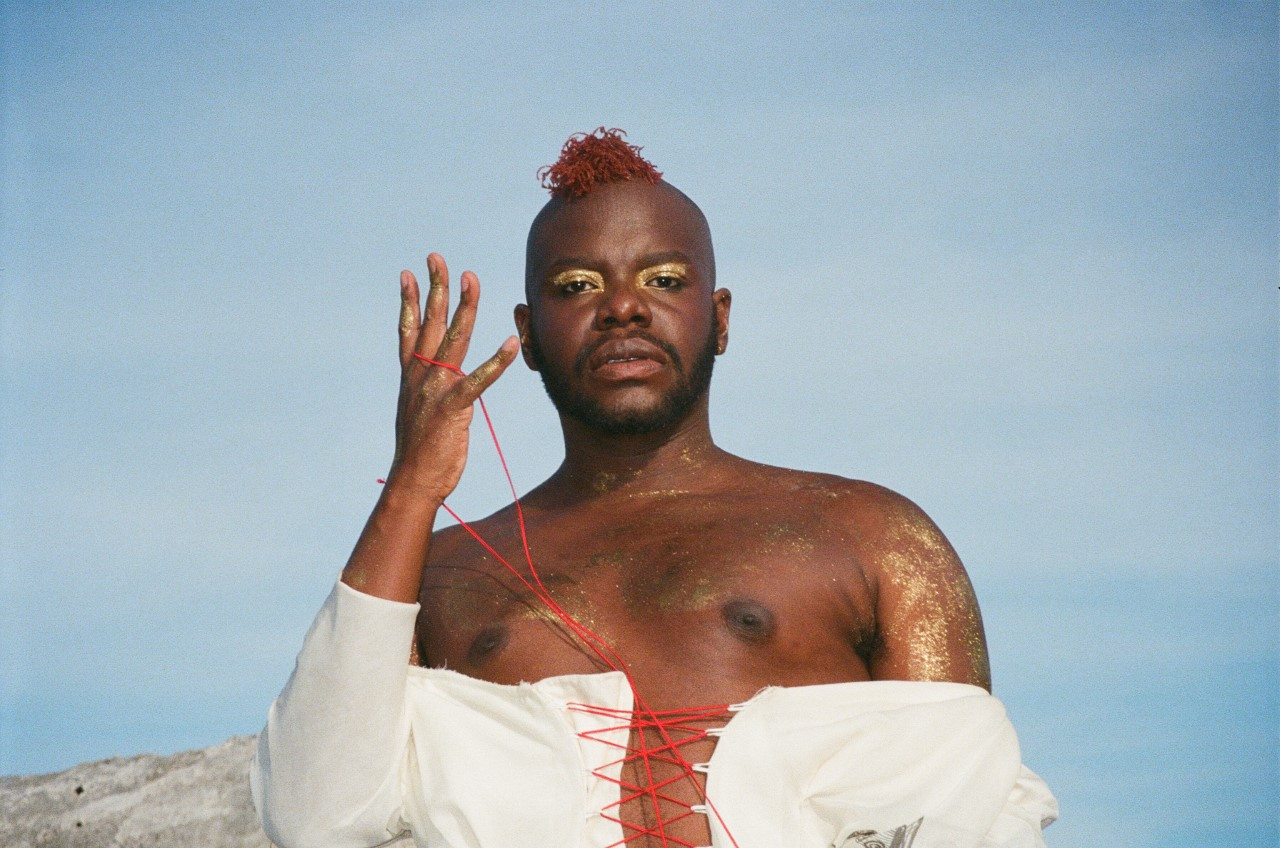Jaamil Olawale Kosoko - Interview for Staging Decadence
Jaamil Olawale Kosoko. Photo by Nile Harris (2020)
Jaamil Olawale Kosoko is a Nigerian American performance maker, poet, curator and teacher. He has taken up numerous fellowships and residencies, most recently acting as Alma Hawkins Visiting Chair at UCLA (2020), and as Princeton Arts Fellow (2017-19). His performances, which have toured internationally, are deeply invested in the intersections between Black cultural history and autobiography. They tend to be highly collaborative – for instance, working alongside model and performance artist IMMA in #negrophobia (2015), and sound artist Jeremy Toussaint-Baptiste in Séancers (2017) – and incorporate richly detailed performance environments, low-fi projection, poetry and spoken word, and the Black dancing body. His work is also deeply invested in the writing of African American scholars, poets and philosophers including Audre Lorde, bell hooks, and Calvin Warren, with performances frequently incorporating and being shaped by live and recorded readings of their work. His most recent corpus – Chameleon (2020) – explores the ‘fatal axis’ of Blackness and queerness in contemporary America. Its live iteration, Chameleon: A Biomythography, has been paused as the coronavirus pandemic runs its course, with an online series of discussions, sharings and performances, American Chameleon: The Living Installments (2.0), having since taken on a life of its own.
How would you describe your work to someone coming to it for the first time?
I try to work in the most expansive sense of performance, so a lot of the work that I do operates both on and off stage. I'm interested in ‘life-craft’ over stagecraft. I’m trying to illuminate something that I see embedded in the affairs of black lives, situating it in the majesty and luminosity that is present in the lives operating around me. I'm trying to transcribe those life practices. I guess I'm trying to figure out ways of displaying and sharing those practices, as well as inside of the classroom. I recently finished my appointment as the Alma Hawkins visiting chair in the World Arts and Cultures / Dance Department at UCLA. Working with those students, it's been really incredible. Specifically now, inside of this two-dimensional reality, via Zoom, it’s meant having to really lean into the ways in which life practice does affect and transcribe into one's creative display and execution. Making those ties more conceptually has brought me to a concept or methodology that I call Socio-Choreological Mapping (SCM). This is a kind of practice that I think is easily transcribed in all sorts of modes. Where and how do life and creative practices intersect? What is it about these intersections that are the most exciting and interesting, but also where are the failures and the bearings and the pivots and the trouble? The idea of Socio-Choreological Mapping has been a way in which I can apply creative practices to my everyday, as well as the teaching, stage craft and multimedia work that I'm doing. I think of it as a kind of radical integration in which I'm attempting to release disciplinary segregations that come up so often, specifically in the US around how one defines their creative work.
It seems that your work around Socio-Choreological Mapping is something enriching to hold onto in spite of the various challenges that the past year has presented. It also makes me mindful of the space you’ve been carving in the virtual sphere with American Chameleon: The Living Installments (2.0), for instance. Despite the challenges of 2020, is there anything else that has emerged over the past nine months or so that you can envisage bringing forward into 2021 and beyond?
I've been thinking a lot about Kathleen Stewart’s writings around atmospheric attunement, and Audre Lorde’s Uses of the Erotic: The Erotic As Power. Some of these feminist theorists are really creating a case for subtle intimacies that rise up through the process of just being in deep connection and practice with the earth, with one's own surroundings, with their community, with practice. All of these things are deeply entangled. I've always been really explicit about how I draw from the autobiographical and lived experience. Also, while live performance has become almost non-existent, that's not to say that deep research and practice is still not as present, if not even more enlivened. Now I think my question for 2021 will be: how best to organize and situate all of this content that has risen to the surface for me? What is the best way to present that kind of archival work and research? I know that I will be going into 2021 with a deeper, more intimate kind of relationship to space, space-making, community, ritual, and all of the life practices that have already been applicable to my stage and media work. But I'm still figuring out what that display will be. I just don't know yet. There's still a lot of interference.
Your remarks just then about cultivating a deeper sense of the relationships between space-making and ritual remind me of how you initially framed your 2015 performance #negrophobia in terms of seeking an ‘ecstatic theatricality’. Could you speak to what this notion means for you now?
I was curious about a kind of abandon inside of the theatrical frame. I was also thinking deeply about trans-ness, what it means to be entranced, and how that pertains to the ecstatic. Since then, much of my process has been about how I heal myself and my body, my spirit, those that I care about, and how can I use this platform to guide through the trouble and traumas of systemic racism and racial violence in contemporary America. It has to be something that is felt and experienced so that I can begin to frame it for a larger public.
Jaamil Olawale Kosoko, Séancers (2017), American Realness Festival. Photo by Ian Douglas.
In a review of your piece Séancers (2017), the critic Nicole Serratore describes your scenography as a ‘varied language of decadence and trash’. What do you make of this?
There is a kind of messiness that has always enchanted me. It's in the complication of the mess, as if its trouble is exposed. At the same time, what is judged to be trash is subjective. Some of it might well be trash, and other parts more than trash. I don't know if I would use the term per se. The materials that I work with, they all have meaning, and a lot of thinking informs each item. So in a way it feels like a bit of a reduction, to call it trash. But at the same time, there is something trashy there that I do recognize in regards to how the materials might be treated at times, or how they are presented. They can resemble a trash aesthetic. I think there is also something about white trash that I am unpacking as I journey into complicated colonialist histories embedded inside of the performance of the ‘séance’. I was interested in exposing and bringing attention to this monster that takes shape and takes up space in the room and begins to take me over, as well as the imagination of the audience. I'm also trying to bring attention to the creature, the monster, the elephant, if you will, or whatever this spectre of evil was that was growing in the space. But by the time we get to the end of that work, we hear a narration by the amazing Ruby Sales: a public theologian who is really confronting this past and this present while also doing it with so much love and care and beauty. So while I wouldn't necessarily choose the word ‘trash’ per se, there is a way in which the use of the materials, no matter how meaningful they may be, do become trashed through a kind of metaphorical gymnastics.
In a press release for Séancers, you describe it as ‘setting the fugitive experience afforded Black people on fire with majesty, opulence and agency’. You used the term ‘majesty’ again in describing your work at the beginning of this interview, but what is it that draws you to this particular tryptic of terms in thinking about Black fugitivity?
I think it affords an opportunity to understand the Black body in a different sort of context. When I think about the abominable cruelty of systemic racism in contemporary America, it's really a crime against humanity, and no one seems to be able to find a way to repair, make amends, or even apologize for it. I find it completely dumbfounding how difficult it seems to be to acknowledge such a historical evil. So my proposal here is to attempt – even for a brief theatrical moment, a brief performative moment – to display a Black being in a way that is both majestic and opulent, and that honours the history, intellectual wealth and beauty that Black people in the world have been able to present even inside of such devastating realities. There continues to be this amazing production of thought and spirit. What is most opulent is a kind of spiritual centre that Blackness, as a proposal for thinking, can bring to the table. Recent uprisings have helped us to understand the magnitude of this spiritual opulence, but do we have to depend on Black people to be the spiritual bearers for the planet? When is enough enough, when the spiritual labouring of Black beings is mined as fuel for the modern world system? Séancers became a platform for me to begin to hold that trouble and spiritual currency, to pull it into the room and see what happens when people are forced to acknowledge what Christina Sharpe calls ‘the Black, dead and dying’, and especially its aftermath. I call upon her notion of ‘wake work’ to express a way of tending and caring for Black life and death. With my newest project, I’m developing a Syllabus for Black Love. Maybe this syllabus will help offer some guidance as to how we might show more love and care for Black folks, which seems to be a difficult job in the world.
“So my proposal here is to attempt – even for a brief theatrical moment, a brief performative moment – to display a Black being in a way that is both majestic and opulent, and that honours the history, intellectual wealth and beauty that Black people in the world have been able to present even inside of such devastating realities.”
Another thread that runs throughout your work – one that seems especially pertinent in 2020 – is an interest in the paranormal, and particularly queer readings of the paranormal.
I’ve only grown more enchanted and intrigued by the paranormal! Paranormal activity, paranormal space, paranormal knowledge production... I’m really curious about ways in which we unknow, ways of unknowing and unlearning as means of uncovering hidden wisdoms. The paranormal is akin to the queer. It’s a way of speaking to what José Esteban Muñoz calls the ‘then and there’. You can’t get there without experiencing and tending to the paranormal in ways that move beyond regular or more traditional ways in which one might otherwise come to understand the world. I’ve landed at a point now where I can recognise that I am completely antithetical to the logic of capitalism, white hetero-normality and imperialistic thinking. All of that is in direct conflict with my body, my own thinking, and the ways in which I understand myself. And that’s not bad, honestly! But it’s taken me a long time to reckon with the fact that this interference that I’ve felt all of my life – call it queer, call it paranormal – is a deeply spiritual source or space for where much of my creativity and sensitivity and ways in which I come to emotionally engage with myself and others comes from. All of that comes out of the paranormal.


